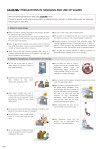
av-en-valves@@@242 / 246
10bãÉBOOKÌy[WÉÚ®µÜ·
241 Below are general precautions for safely using valves. Precautions specific to each product are provided in a separate instruction manual. For details, please contact our nearest distribution agent or sales office. 1. Notes for pipe design 2. Notes for acceptance, transportation and storage Make sure that the working temperature and pressure are within the tolerance range during operation. (The maximum working pressure is the value including the water hammer pressure. If the tolerance range is exceeded during use, the valve may be damaged.) Select an appropriate material to use. (Some kinds of chemical may erode the surface of parts, causing breakage.) For details, consult our nearest sales office in advance. When using a fluid that contains crystalline fluid, use it in a condition where the fluid does not recrystallize. (The valve may become unable to work properly.) Consult us when using a fluid containing slurry. This product is not explosion-proof. Do not use it in explosive atmospheres. (Doing so may cause breakage or explosion.) Operating pressure of pneumatic type automatic valve: The standard operating pressure of pneumatic type is 0.4 MPa {4.1 kgf/cm2}. When increasing the operating pressure, ensure that the pressure is within the specified range of operating pressure. Do not joint with solvent adhesive or welding connection on differential plastic materials.(It may cause damage.) Do not ride on the valve or place a heavy object on the valve. (Doing so may cause breakage.) Keep fire and hot object away from the valve. (Doing so may cause deformation, breakage or fire.) Avoid direct sunlight and store it indoors. Also avoid storing the valve in a place that may be exposed to high temperatures. (Doing so may cause deformation.) Do not give an impact by throwing, dropping or hitting the valve. (Doing so may cause damage or breakage.) Do not scratch or stick a sharp object (such as a knife and hook) into the valve. Do not pile packed cardboard boxes on top of another too much, to prevent collapsing of the boxes. Do not allow the valve to come in contact with coal tar, creosote (wood preservative agent), white ant exterminating agent, pesticide, or coating material. (Doing so may cause swelling and resulting breakage.) Be very careful when hanging or slinging the valve. Do not stand under the suspended object. Keep the valve in a cardboard box until just before piping installation. Avoid direct sunlight and store it indoors (at room temperatures). Also avoid storing the valve in a place that may be exposed to high temperatures. (Cardboard boxes become weak when get wet. (Take due care when handling and storing the boxes.) When transporting the valve, do not use the handle to secure the valve. After unpacking, check that the product has no abnormality and conforms to the specifications. Creosote Pesticide Coal tar PRECAUTIONS IN HANDLING AND USE OF VALVES